The White-breasted Thrasher (Ramphocinclus brachyurus) is an Endangered songbird with an extremely small and increasingly fragmented range. Over 80% of the global population is found in Saint Lucia, most of it within the Mandelé range, which is considered the stronghold for the species at about 1,000 adults. (the remaining 20% is in Martinique). Bela Barata, Field Programme Officer with Durrell Wildlife Conservation Trust, takes us into the field to find and study this elusive bird.
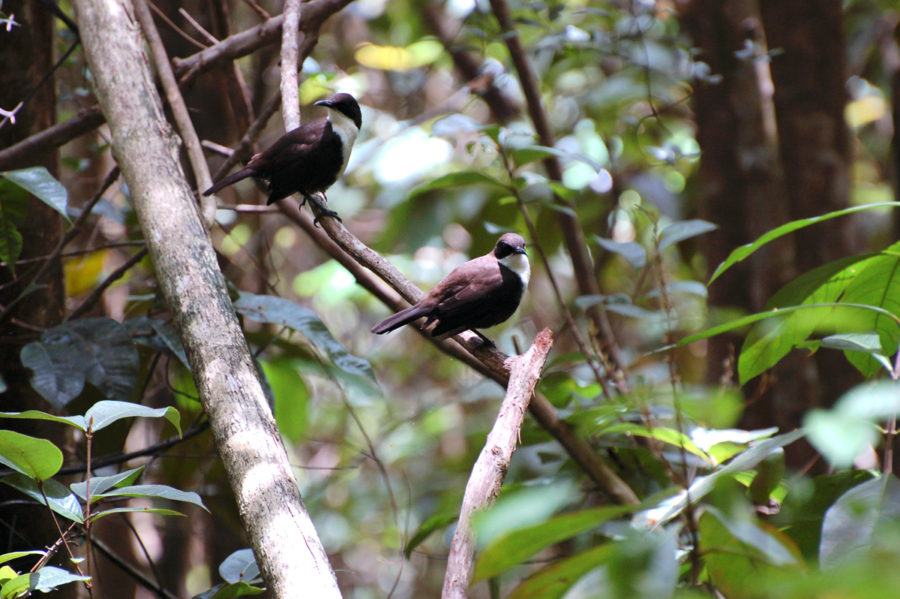
On a sunny February morning, beneath the canopy of dry scrub forest along the central East Coast of Saint Lucia, staff of Durrell Wildlife Conservation Trust, Saint Lucia National Trust and the Division of Forestry prepared to complete the day’s task: checking camera traps in White-breasted Thrasher territory. One factor that limits reproductive success of this bird is nest predation by native predators such as the Saint Lucia boa constrictor and non-native predators such as rats, cats, and mongoose. The team had recently installed a network of camera traps, which take photos when trigged by motion, across the Mandelé range to get an indication of potential predator abundance in the area. These cameras were being monitored on a regular basis by Durrell and our partners.
Saphira Prepares to Meet the Thrasher
This assignment would turn out to be a great occasion for Saphira Hunt, Conservation Assistant at the Saint Lucia National Trust and Durrell’s Project Officer. Saphira has been working to raise people’s awareness to conserve this endangered bird for a number of years. Surprisingly, she has never seen a thrasher in the bush. On that day, however, while checking the cameras, she would come across the Endangered White-breasted Thrasher for the very first time in her life.
Saphira was thrilled with the opportunity and she vividly recalls her excitement: ‘We were trekking into Fer de Lance (Saint Lucia pit viper) territory with two tasks at hand. One was to check on the camera traps placed in the thrashers’ nesting sites and the second task was to see a White-breasted Thrasher live in its habitat—a first for me. Adorned with knee high snake gators, rubber boots, machetes, and snake hooks, we set off on the first trail ever, vigilant for any Fer de Lance along the way. The first camera trap was 5 meters ahead. Guided by a GPS unit, we walked single file; I strategically placed myself between two Forestry Officers each wielding a machete. I figured this positioning would decrease my chances of encountering the venomous Fer de Lance. As much as I was excited to see the White-breasted Thrasher in the wild, it would also be my first time seeing the Fer de Lance in the wild.’
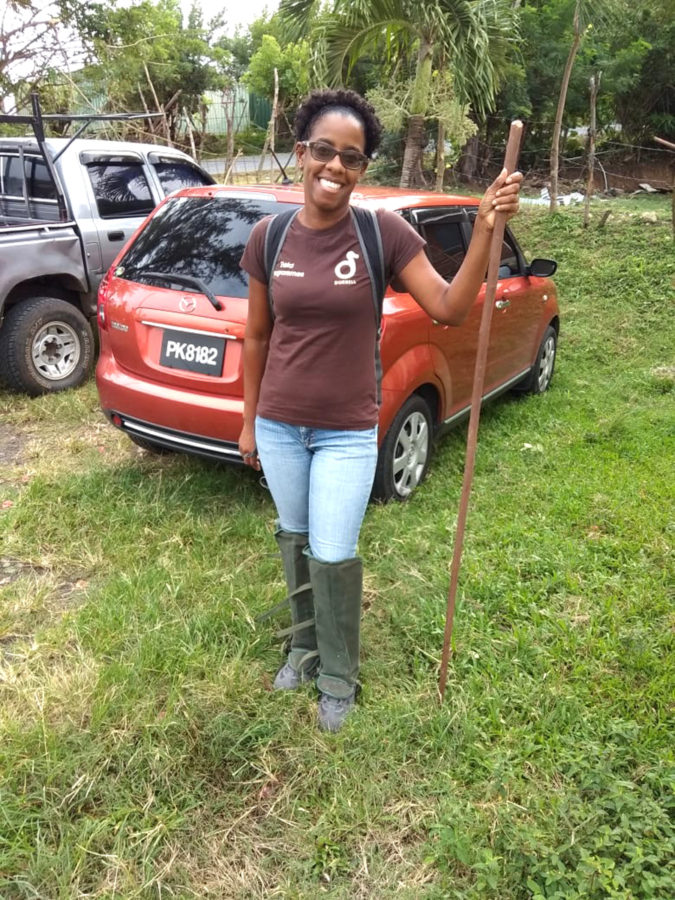
The Sound of Silence (and the Thrasher’s Call)
As we trotted on, we kept our ears and eyes peeled, looking to the ground in hope of seeing the bird thrashing in the leaf litter or calling out to a mate. The lead Forest Officer spotted the first camera trap, while our team got ready to check the SD card for photos of potential predators. The area was scanned for any presence of Fer de Lance. We checked the first camera, and then another one. While we were on the move, a member of our team spotted the thrasher. Everyone stopped to admire, and then silence ruled: we heard nothing but the thrasher’s call.
Saphira describes her first sighting: ‘Onward, forward we went, checking two more camera traps along the trail. Suddenly, we heard the distinctive call of the White-breasted Thrasher. Pius Haynes (Senior Wildlife Conservation Officer of the Forestry Division) moved slowly forward, trying to spot the pair. There they were, perched on a low hanging branch. Everyone moved aside to allow me to quietly walk up to meet Pius where he pointed out the White-breasted Thrasher to me. Oh, what a sight! With their dark topcoats and blinding white under bellies, they were a stunning pair. I stood there in total silence letting the sounds of the forest fill my senses as I watched in awe.’
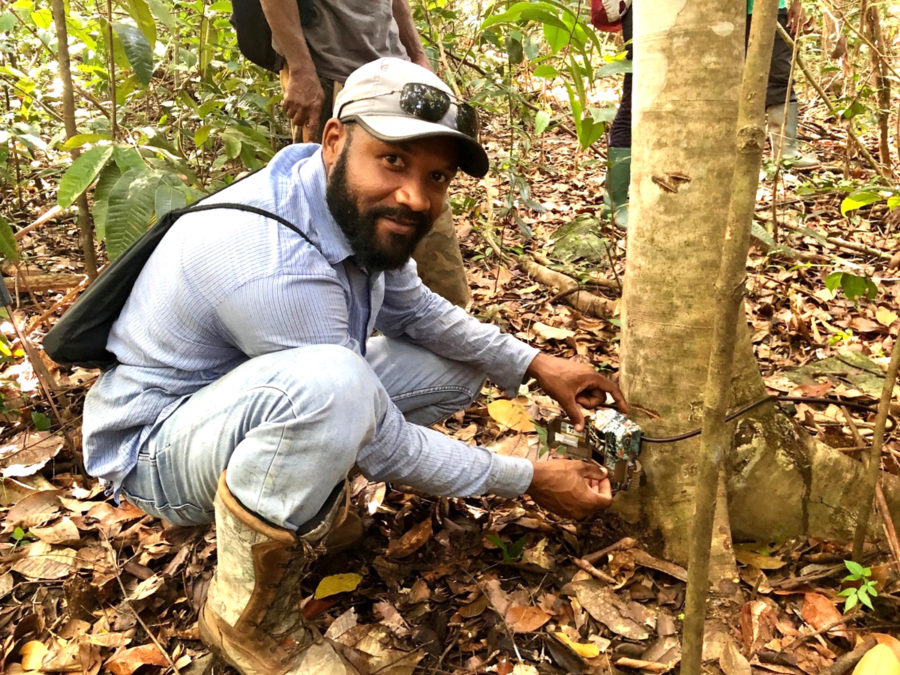
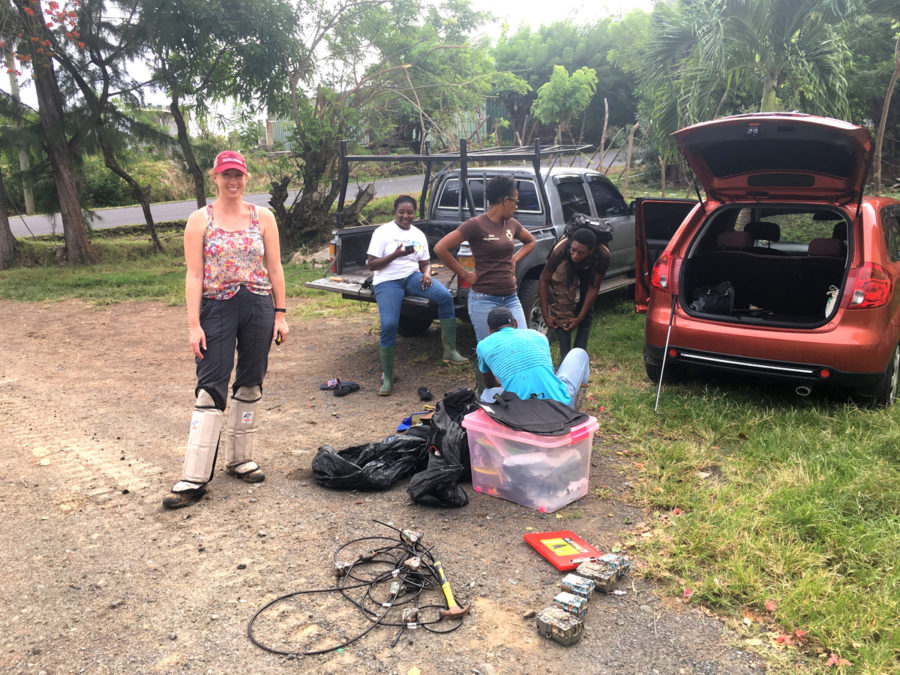
An Action Plan Took Shape in 2014
Saphira experienced a unique moment; the view of a rare and magnificent bird is something hard to forget. The White-breasted Thrasher was once more widespread in Saint Lucia, but the population is thought to be declining due to fragmentation of dry forest, the thrasher’s habitat, and increased depredation by non-native invasive species, such as rats, domestic cats, and mongoose. Our collaborator, Jennifer Mortensen from the University of Arkansas has been studying the ecology of the White-breasted Thrasher since 2006 and co-wrote the Species Action Plan (produced in 2014). Jennifer describes with great satisfaction how it feels to see a conservation plan being put forward for this species:
“I remember the day. It was 2014. A beautiful February afternoon. This was my 8th trip to Saint Lucia, but the first time visiting during the “winter.” Clear skies, slight breeze, low humidity, few mosquitos. Why had I always come during the “summer” rainy season? Well, for one, the mangoes. But more importantly, I suppose, the rainy season is the breeding season for the White-breasted Thrasher. And I love that bird. They are kings of the dry forest. They are spunky. Some say they have an understated elegance that is unrivalled across the Caribbean. And they are Endangered, which is why we met that afternoon in Dennery in February of 2014 to hash out the species’ first conservation plan. This plan, called the Gòj Blan Plan after the thrasher’s local Kwéyòl name, leads directly to the work we are doing now, six years later. To see those discussions and all that planning turning into conservation action is really exciting.”
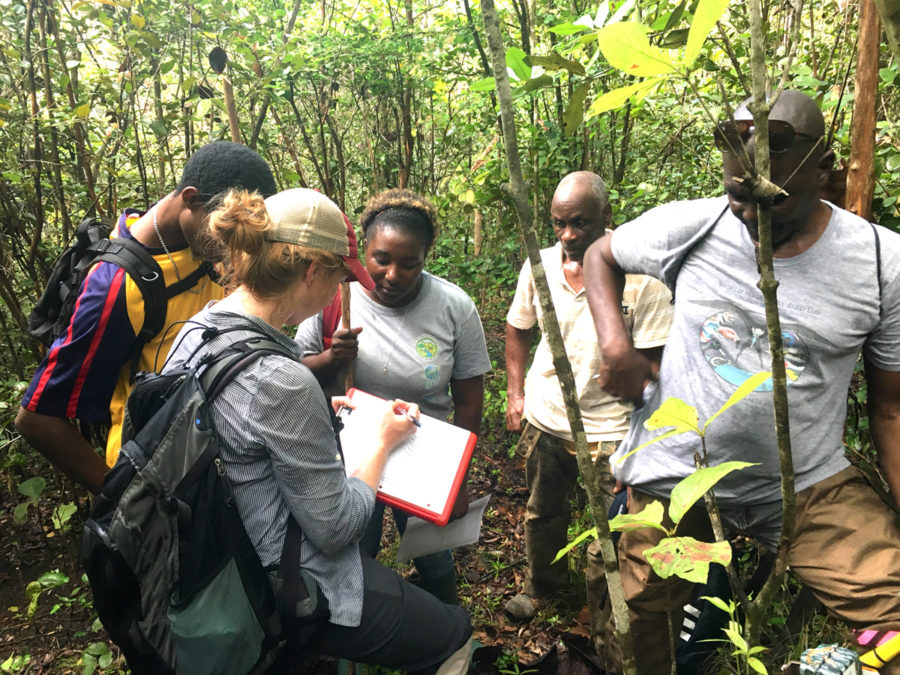
Jennifer recently returned to Saint Lucia to support implementation of our White-breasted Thrasher project. She was a little nervous to return to Saint Lucia after six years away. She recalled, “While I’d kept in touch with friends and colleagues, and often thought about thrashers (still analysing field data), I didn’t know what to expect. However, seeing the Pitons as we approached the island, the colourful roofs of Vieux Fort, the faces of friends at airport arrivals, and then finally, being back in the bush with the thrashers—it felt, at once, like no time and all the time had passed. Birds we banded in 2012, now 8 years older, were still thrashing about in the leaf litter only 60m from where we last encountered them.”
Betty Petersen Grant Supports Predator Study
We are working with a wide range of collaborators, partners, and funders to save and protect this endangered bird. With the support of BirdsCaribbean’s Betty Petersen Conservation Fund, our current work is looking into nest predation and investigating the abundance and activities of invasive predators like the mongoose. Predation is considered the primary cause of White-breasted Thrasher nest failure. It is also suspected to be the most important cause of juvenile mortality. Data we collect on non-native predator abundance and locations via our camera trap network will serve as a baseline and will assist us in the design of a non-native predator control programme, which is the next step of the project.
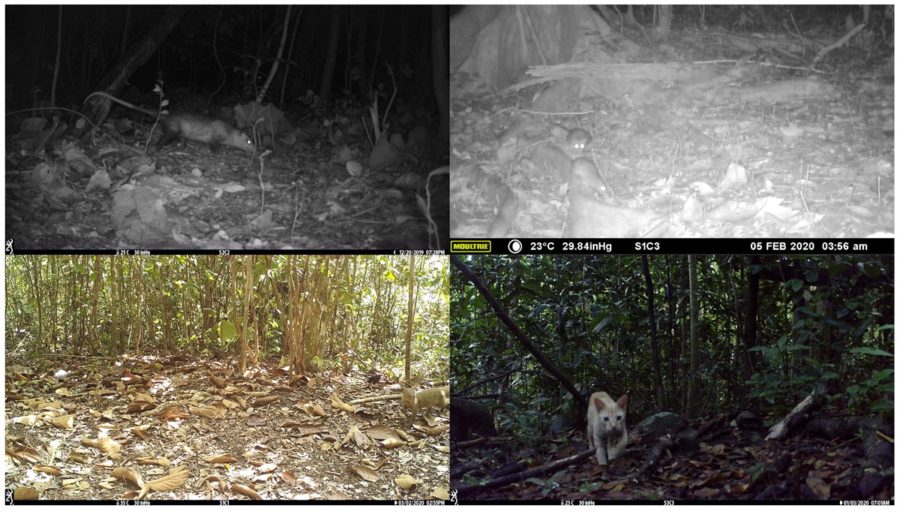
These activities are based on the Gòj Blan Species Action Plan and will help determine if directed non-native predator control is a viable management strategy to improve nesting success of the White-breasted Thrasher or whether efforts should be focused on other management strategies. We have a dedicated team comprised of wildlife officers, naturalists, and conservationists from the Saint Lucia Forestry Department, Saint Lucia National Trust, and Durrell Wildlife Conservation Trust. Together, and with BirdsCaribbean support, we are ready to promote the conservation of the White-breasted Thrasher in Saint Lucia. We look forward to reporting back after our next field season!
COVID-19 UPDATE
First case of Covid-19 in Saint Lucia was recorded in March 2020, followed by the government announcement of restricted rules to contain the spread of the virus: international flights were prohibited, a curfew was imposed, only essential shops remained opened, and schools were closed.
Our 2020 project goals of beginning the non-native predator control program and schools-based outreach activities could clearly not go on as planned. With schools closed, awareness activities will be postponed until the next academic year. Given the major disruption in international shipping, the equipment needed to implement the invasive species control program could not be delivered, causing us to shift this activity to next year as well. However, all was not put off… Ahead of us was the challenging task of completing another season of White-breasted Thrasher nest monitoring, initially proposed to start shortly after the predator control program in May 2020.
A Safe and Successful Nest Monitoring Season
Field activities were on-hold until July 2020, which is when the government granted permission to start reopening businesses and offices, following specific guidance and safety measures. Since outdoor activities such as fieldwork were considered safe, our team could proceed with nest monitoring. Bela Barata, Programme Officer for Durrell Wildlife Conservation Trust, said ‘of primary concern was the health and safety of our local staff, who are essential in delivering fieldwork and collecting all the data that underlie our efforts to save and protect the White-breasted Thrasher’.
In Saint Lucia, White-breasted Thrashers may breed between April and September, so we had to act quickly if we wanted to get a good sample of nests to monitor this year: ‘we had to adapt to the current scenario, make appropriate changes to deploy a reasonable survey effort and also ensure this could be done in the safest way possible’, said Bela. To safely deliver this activity, we reduced the field team to two people to ensure social distancing and used trail cameras to ‘watch’ nests. The cameras allowed us to reduce site visits to only once per week where we simply retrieved camera data, limiting contact between team members.
Camera traps were successfully installed in July 2020 and deployed for 1½ months. We recorded a total of 19 White-breasted Thrasher nests during this period, with nests occurring across each of our four field sites. Most importantly, by the end of the monitoring season, our team was well and healthy. We are now working to share the dataset, which contains thousands of photos. With this data our team will be able to calculate nest success, stages of nest failure, nest visitation by potential predators, and depredation events.
The success of this season survey under a global pandemic scenario was only made possible due to a well-coordinated response and the support of multiple partners. Saint Lucia National Trust and Durrell Project Officer, Saphira Hunt, was able to put together all equipment needed for field work in a noticeably short time. Saint Lucia Forestry Department staff was on stand-by, ready to install the cameras at any moment. Our White-Breasted Thrasher expert, Jennifer Mortensen from the University of Arkansas, worked quickly to provide a revised and updated monitoring protocol, setting a step-by-step guide that supported our field team without in-person supervision. From all lessons learnt, the delivery of the nest monitoring this year proved that we have a terrific in-country capacity, which is the bedrock of a relationship of trust and crucial for the long-term sustainability of this project. Together, we are working to achieve one shared goal: saving the White-breasted Thrasher from extinction.
By Bela Barata. Bela is Project Officer with Durrell Wildlife Conservation Trust. She coordinates this project, providing logistic support to the team in the field to deliver project activities, and she provides regular updates on the activity plan.
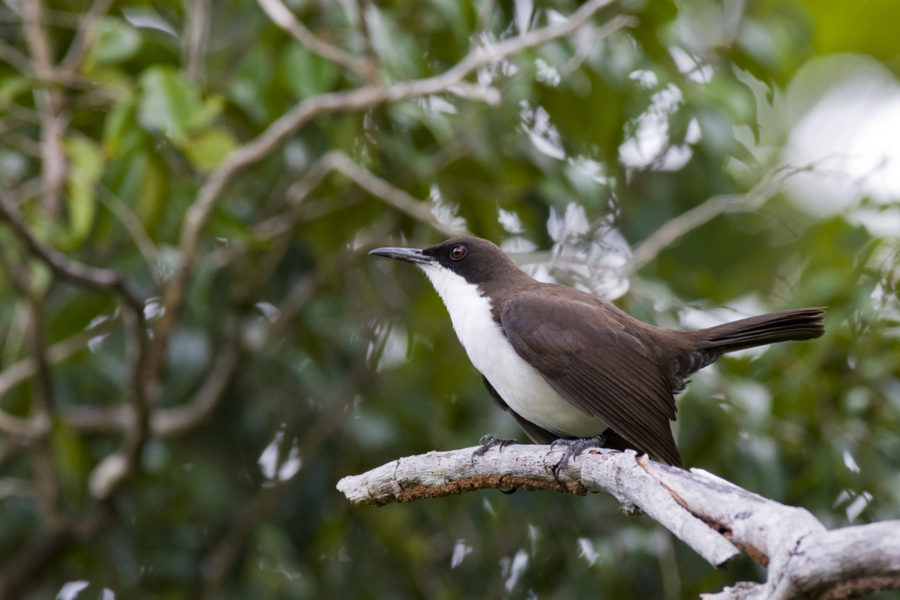

Thanks for that report! We can help save this and other species if we rally together!
Thanks Alleyne, we agree with your comment!!! Warmest best, Lisa
What a beautiful bird! Thanks for the information and photos.
Thanks for your comment, Deb – the White-breasted Thrasher is such a striking bird, we are excited about this research and plans to save this endemic bird from extinction. We shall keep you posted on further updates on the project. Take care! Lisa Sorenson